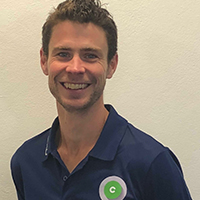
With the spike in COVID-19 cases leading to a lockdown in Sydney, gyms and swimming pools are closed, team sports are off, and a lot of people aren’t able to continue with their normal exercise routines. Staying fit and active during this challenging time is more important than ever, and running is once again the most accessible way to exercise for a lot of people. Adding some structure to your running routine can really help you stay motivated and get the most out of your training sessions, so here are four running sessions that will help you get faster over 5km and 10km!
Session 1: 3-6x1km @ current 5k pace +5-10%
Let’s use the example of someone who can run 5km in 25mins. That is equal to 5min/km for each km.
5mins = 300seconds (5×60).
To calculate the +5% pace: 300 x1.05 = 315sec (5mins 15sec per km)
to calculate the +10% pace: 300 x 1.10 = 330sec ( 5mins 30secper km)
For this runner they should aim to run 3-6x1km reps between 5mins 15sec to 5mins 30sec. The recovery for this type of session should be a slow jog of between 60-75secs. This session allows you to run at a strong but controlled rhythm. The aim is for the legs to feel heavy and tired by the end but your breathing should not be overly laboured. If you are unable to jog in the recoveries you have gone too hard. The number of reps you do will depend on your running background and current fitness level. Beginners would try for 3 reps whereas more experienced runners can aim to get to 6 reps. You are not trying to run as fast as you can on this session. You should finish feeling like you could have done another couple of reps if required.
Session 2: 4-7x2mins @ current 5k pace – 3%
Let’s use the same example of someone who can run 5km in 25mins. That is equal to 5min/km for each km.
5mins = 300seconds (5×60)
To calculate the -3% pace: 300×0.97 = 291 (4mins 51sec)
For this session our hypothetical athlete should try and run 4-7x2min reps @ at pace of 4mins 51sec. The recovery for this type of session should be 90sec standing recovery. The intensity is higher on this session and therefore we are more generous with the recovery. This session teaches the body to run faster than race pace. It develops efficiency at 5 and 10k paces, making that pace feel easier on race day. You should feel from about rep number 4 onwards quite challenged. Your breathing will be a lot heavier than in session 1 and you’ll probably find the need to put your hands on your knees to recover better in the last half of the session.
Session 3: 3-4×6-8mins @ current 5k pace +10-12%
Using the same runner who can run 5km in 25mins. That is equal to 5min/km for each km.
5mins = 300 seconds (5×60)
To calculate the +10% pace: 300 x1.10 = 330sec (5mins 30sec)
To calculate the +12% pace: 300×1.12 = 336sec (5mins 36sec)
The recovery for this type of session should be 75-90sec slow jog recovery. A longer session in total duration to session 1 at slightly more moderate speeds. The goal of this session is the develop the stamina for the middle parts of your 5 and 10km races. Similar to session 1 we want you feeling more heavy in the legs than really out of breath on this session. You should feel throughout the session if you needed to pick up the pace you could but you notice each rep your legs are becoming a little heavier and it requires a bit more concentration to hold the pace each rep.
Session 4: 20-30min run @ current 5k pace +15%
Once again we’ll use the example of our runner who runs 5km in 25mins. That is equal to 5min/km for each km.
5mins = 300 seconds (5×60)
To calculate +15% pace: 300 x1.15 = 345sec (5mins 45sec)
This is a continuous run without any recovery periods. Greater concentration is required to maintain a steady pace throughout. This can be helpful for teaching you to maintain pace in racing situations when things start to get a little tough and your brain is trying to tell you to slow down. Exposing yourself in training to continuous efforts better reflects the demands of racing. This type of session teaches your body to delay the onset of lactate accumulation. It should feel like you are right on the edge of going over that red line where you will be forced to slow down, and holding it for the duration of the run. It is better to err on the side of caution with this session and start a little slower and build into the run so that you don’t go over that red line and defeat the purpose of the session.
Whether you’re a regular runner or are new to running and just using it to stay fit during the COVID lockdown, following these programmed running sessions will help get the most out of your training. Having some structure and targets to work towards can also help keep you motivated.

These sessions have been programmed for you by Ben Liddy, one of our Directors and Head of Running Performance. Ben is a certified Level 4 IAAF running coach as well as being a running physiotherapist. He is extremely passionate about running & loves working with both our recreational and elite athletes.
Ben specialises in treating running injuries as well as delivering our running performance program. He works with recreational runners and also coaches our invitation-only elite run squad, Central Performance Track, which includes runners from state to national and Olympic level. If you have any questions or you’re looking for a more specific individual plan please contact Ben at ben@centralperformance.com.au
Online Running Coaching Available
If you’re looking to really push your running performance we can now provide you with Online Running Coaching. Ben can set you up with a personalised program that is tailored to your current fitness level, running goals and any injury history. This service is delivered online so is a great option during the current lockdown in Sydney. Please contact Ben on Ben@centralperformance.com.au or contact us for more information.

